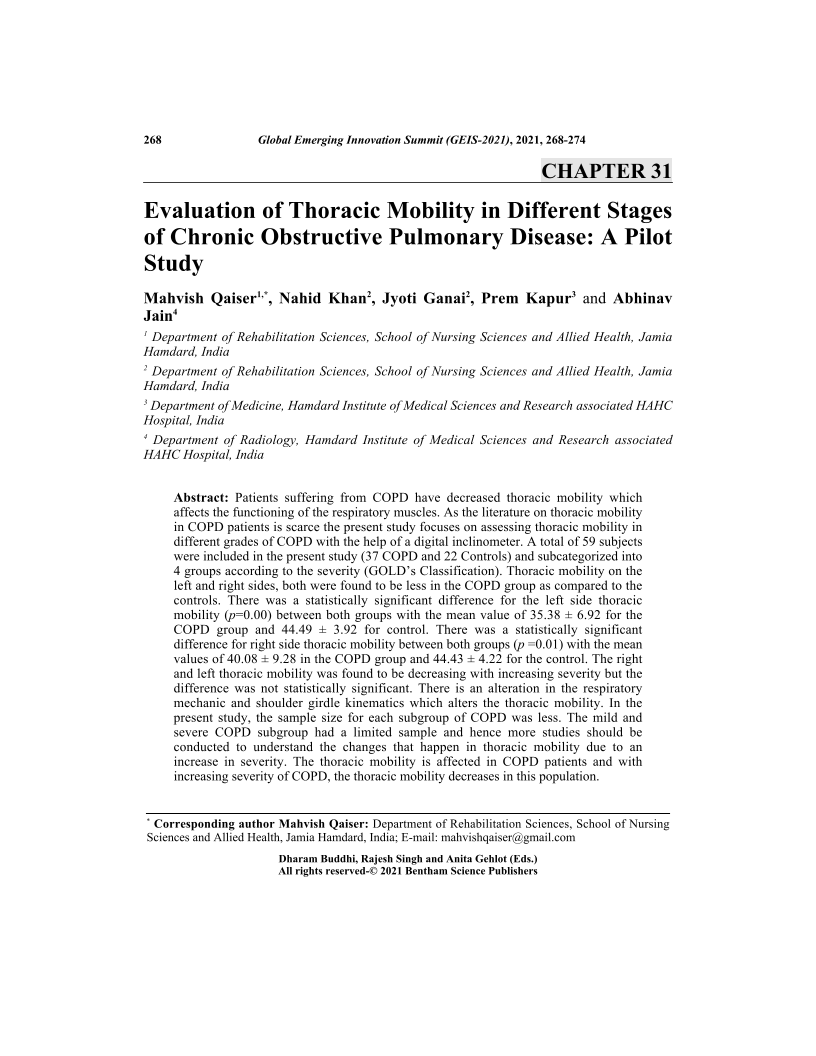oa Evaluation of Thoracic Mobility in Different Stages of Chronic Obstructive Pulmonary Disease: A Pilot Study

- Authors: Mahvish Qaiser1, Nahid Khan2, Jyoti Ganai3, Prem Kapur4, Abhinav Jain5
-
View Affiliations Hide AffiliationsAffiliations: 1 Department of Rehabilitation Sciences, School of Nursing Sciences and Allied Health, Jamia Hamdard, India 2 Department of Rehabilitation Sciences, School of Nursing Sciences and Allied Health, Jamia Hamdard, India 3 Department of Rehabilitation Sciences, School of Nursing Sciences and Allied Health, Jamia Hamdard, India 4 Department of Medicine, Hamdard Institute of Medical Sciences and Research associated HAHC Hospital, India 5 Department of Radiology, Hamdard Institute of Medical Sciences and Research associated HAHC Hospital, India
- Source: Global Emerging Innovation Summit (GEIS-2021) , pp 268-274
- Publication Date: November 2021
- Language: English
Evaluation of Thoracic Mobility in Different Stages of Chronic Obstructive Pulmonary Disease: A Pilot Study, Page 1 of 1
< Previous page | Next page > /docserver/preview/fulltext/9781681089010/chapter-31-1.gif
Patients suffering from COPD have decreased thoracic mobility which affects the functioning of the respiratory muscles. As the literature on thoracic mobility in COPD patients is scarce the present study focuses on assessing thoracic mobility in different grades of COPD with the help of a digital inclinometer. A total of 59 subjects were included in the present study (37 COPD and 22 Controls) and subcategorized into 4 groups according to the severity (GOLDs Classification). Thoracic mobility on the left and right sides, both were found to be less in the COPD group as compared to the controls. There was a statistically significant difference for the left side thoracic mobility (p=0.00) between both groups with the mean value of 35.38 ± 6.92 for the COPD group and 44.49 ± 3.92 for control. There was a statistically significant difference for right side thoracic mobility between both groups (p =0.01) with the mean values of 40.08 ± 9.28 in the COPD group and 44.43 ± 4.22 for the control. The right and left thoracic mobility was found to be decreasing with increasing severity but the difference was not statistically significant. There is an alteration in the respiratory mechanic and shoulder girdle kinematics which alters the thoracic mobility. In the present study, the sample size for each subgroup of COPD was less. The mild and severe COPD subgroup had a limited sample and hence more studies should be conducted to understand the changes that happen in thoracic mobility due to an increase in severity. The thoracic mobility is affected in COPD patients and with increasing severity of COPD, the thoracic mobility decreases in this population.
-
From This Site
/content/books/9781681089010.chapter-31dcterms_subject,pub_keyword-contentType:Journal105

